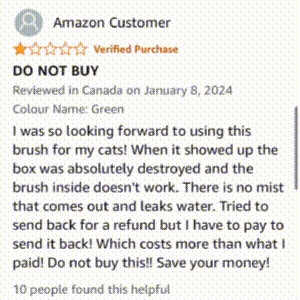The pet grooming market is constantly evolving, offering a wide array of brushes designed to keep our feline friends looking their best. Among the latest trends are pet brushes that utilize water or steam, marketed for their supposed efficiency in grooming. One such type gaining attention is the “Cat Steam Brush,” often promoted for its ability to loosen fur and provide a soothing experience for cats. However, while these innovative tools might seem appealing, it’s crucial to consider potential downsides, particularly concerning hygiene and the risk of mold growth.
The idea behind incorporating water or steam into a cat brush is often to dampen the fur, making it easier to collect loose hair and reduce static. Some designs feature reservoirs to dispense water or mist during brushing. While this might sound beneficial, it inadvertently introduces moisture, which, if not managed correctly, can create a breeding ground for mold and bacteria. And when it comes to mold exposure, pets, unfortunately, are often more vulnerable than humans. Their smaller size and less developed immune systems make them more susceptible to the harmful effects of fungal spores. Even minimal mold exposure can lead to significant health issues in cats.
 Cat grooming
Cat grooming
The Hidden Dangers of Mold for Cats
Mold can negatively impact cats in several ways. Their fur can trap mold spores, making it difficult for them to eliminate these allergens. Furthermore, cats often groom themselves, and if mold spores are present on their coat, they can ingest them, potentially leading to gastrointestinal problems and other health complications.
Why Steam or Water Brushes Can Increase Mold Risk
Moisture Retention is Key
The primary concern with cat steam brushes or any brush that uses water is moisture retention. These brushes, especially those with built-in water compartments, can trap dampness within their structure. This creates an ideal environment for mold spores to flourish. If the brush isn’t meticulously dried after each use, or if water remains stagnant in any reservoir, mold growth becomes highly probable.
Drying Challenges
The design of many steam or water-based brushes can make thorough drying difficult. Intricate components and reservoirs may not be easily accessible or well-ventilated, hindering the evaporation of moisture. This persistent dampness significantly increases the likelihood of mold formation over time.
Mold Allergens and Respiratory Issues
Mold releases spores that can become airborne or directly transfer to your cat’s fur during grooming. If a brush is contaminated with mold, both the cat and the owner can be exposed to mold allergens during grooming sessions. For cats, mold exposure can trigger respiratory problems, allergic reactions, and exacerbate pre-existing conditions like asthma.
Potential Health Risks
Exposure to mold isn’t just a matter of allergies. Certain types of mold can produce toxins that are harmful if inhaled or ingested. While the risk level depends on the specific type of mold and the duration of exposure, it’s a health concern that shouldn’t be ignored, especially for vulnerable pets.
Protecting Your Cat from Mold Exposure from Grooming Tools
If you choose to use a cat steam brush or a similar product that incorporates water, diligent maintenance is paramount to minimize mold risks.
Rigorous Cleaning Procedures
Clean the brush thoroughly after every use. Pay close attention to the bristles and any water-holding components. Use pet-safe cleaning solutions that are designed to inhibit mold and bacterial growth. Ensure you rinse all cleaning solutions thoroughly after washing.
Regular Mold Inspections
Inspect your cat steam brush regularly for any signs of mold or mildew. Look for discoloration, dark spots, or a musty odor. If you detect any of these signs, clean the brush immediately and intensely. If the mold is extensive or you can’t effectively clean all parts of the brush, it’s best to discard it and opt for a safer alternative.
Consider Safer Brush Alternatives
If you are concerned about the potential for mold, the safest approach is to choose a cat brush that does not rely on water or steam. Effective grooming doesn’t necessitate moisture. High-quality, well-designed dry brushes can effectively remove loose fur and keep your cat’s coat healthy and clean without the added risk of mold. Brushes made from single materials and those that are plastic-free are often easier to clean and maintain, further reducing hygiene concerns. Look for brushes that can be easily sanitized to ensure your pet’s safety.
When selecting a cat brush, prioritize quality and design from reputable brands. Be wary of generic products sold under multiple names, as these may lack quality and safety standards. Reading genuine customer reviews can provide valuable insights into a product’s effectiveness and durability.
Ultimately, choosing the right grooming tools for your cat is an important aspect of pet care. By understanding the potential risks associated with cat steam brushes and prioritizing hygiene and safety, you can make informed decisions that benefit your feline companion’s health and well-being.
